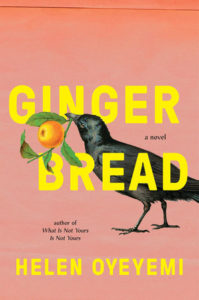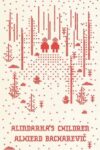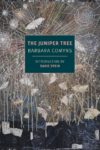 [Riverhead, 2019]
[Riverhead, 2019]
In her seventh book, Gingerbread, the British novelist Helen Oyeyemi delivers a characteristically beguiling origin story that follows the fortunes of three generations in the Lee family. Oyeyemi has always been fascinated with folklore, and the novel subtly works elements of the fairy tale into modern British life. Gingerbread is essentially a family saga in the form of two interconnected mother-daughter stories, in which the women repeatedly flee from constraining institutions, whether in the form of a farmstead, a factory, or a benefactor’s family mansion. Oyeyemi’s women struggle to preserve their families, which tend to grow and diminish with informal adoptions, abandonments, and betrayals. Despite its fantastic trappings, the novel is deeply concerned with the instability of family and with the ways in which family can be defined, revoked, and discovered.
Perdita Lee, an eccentric, isolated British schoolgirl, lives with her single mother, Harriet, an adult education teacher, and her hardy grandmother, Margot. The novel’s drama begins with Harriet’s discovery of Perdita’s catatonic body after her ingestion of self-made gingerbread and a toxic additive in a supposed suicide attempt. Harriet realizes that her daughter’s incident is connected with the machinations of the Kercheval family, relatives who had sheltered her and her mother when they had first emigrated to Britain until they fell out of favor. As Perdita recovers consciousness, Harriet recounts her childhood on the ill-defined island of Druhastrana, her friendship with Gretel Kercheval, her escape to Britain, and her fitful life in the Kercheval household.
In Harriet’s account, Harriet and Margot are able to escape the farmstead and other oppressive institutions through a combination of luck, resourcefulness, and stubbornness. They are reminiscent of strong heroines from established fairy tales, like Gretel from the Brother Grimm’s “Hansel and Gretel,” to which the novel consistently refers, and “Little Red Riding Hood,” because they manage to outwit devious, more powerful adversaries through cleverness and preternaturally good fortune. Harriet escapes the farmstead to the city when she rescues the daughter of the farmstead owner and demonstrates the lucrativeness of her family gingerbread recipe. Much of the novel, especially the sequence when Harriet and Margot have fled Druhastrana and are invited to stay with the Kerchevals in their British mansion, can be read as a loose retelling of “Hansel and Gretel.” In the fairy tale, a cannibalistic witch lures the two children into her gingerbread house and fattens them up for her consumption. Harriet and Margot are invited by Ari Kercheval to his mansion so that he can soothe his guilty conscience with an act of charity towards his distant relatives. Like Hansel and Gretel, the Lees are held ransom and must disentangle themselves from a form of captivity. They are indebted to the Kerchevals and can never fully repay their relatives’ generosity. Eventually, the pair depart the house when they discover evidence of Ari’s underhanded dealings in his business. But the Kerchevals continue to trail them through alternate means, as if Harriet and Margot were wayward children who abandoned the family. The irony is that they desire independence from the family who once sheltered them and at the same time, they remain reliant on them for financial and emotional support. Margot continues to phone Ari Kercheval weekly even after she has moved out of the house and denounced him for exploiting her and her daughter. Harriet hastily enters into a love affair with one of the Kerchevals despite his mother’s impassioned resistance and her own misgivings about the boy’s sincerity. The families are both attracted and repulsed by each other in equal measure, but they cannot live apart.
As the Lees flee from the Kerchevals, they find themselves closer than ever before. A state of freedom, like Harriet’s affair with Gabriel Kercheval, quickly shows itself as a form of bondage to the family, when she mothers Perdita with him. The two families are bound by blood but also by cosmic design. The Lees and Kerchevals realize they are essential to each other’s happiness when reunion and cohabitation become the only methods for freedom from enmity and misunderstanding.
In the novel, Harriet’s extended account of a family history answers the mystery of the enigmatic events in the present. She faithfully works from the remote past into the present. In a story within a story, Oyeyemi interrupts a present stream of events with another self-contained narrative. At various turns, the author reminds us that Harriet is the narrator of the history, that it is a memory rather than an authoritative record. The listeners, Perdita and a troupe of animated dolls, question the veracity of the events, their causes, and the actors’ motivations. Oyeyemi’s puzzle-box structure allows her to consistently exert pressure on Harriet’s narrative and probe at its reliability. Oyeyemi dismisses the idea of a single indisputable account of events. The author lingers closest to Harriet’s perspective, but her narrative structure reveals its limitations. In an act of empathetic understanding, Harriet realizes that everyone holds a different interpretation, a unique rationalization of what had occurred between them: “Everybody around her was living out a different story in which events had different causes and motivations according to how they were perceived.”
Much of the novel’s conflict arises because of the misperception that occurs when characters attempt to read each other’s motivations. When Harriet is a child, she exhausts the books in her home and moves on to reading faces. And when she moves into the Kercheval house, she ranks the family members in order of readability, that is, by the transparency of their intentions as reflected in their early interactions. But there is something ironic about the list because Oyeyemi’s characters tend to be capricious, obscure, and unreadable. They wear different guises, adopt false names, and disappear without notice. Much of the novel is devoted to Harriet’s sounding out of other characters, to her grasping at their true natures. For the reader, the characters also seem cryptic because of Oyeyemi’s disorienting manner of characterization. She starts at a point of caricature and then humanizes her characters by exposing the limitations of that caricature. Oyeyemi’s initial description of the Lee’s benefactor, Aristide Kercheval, is hyperbolic and approaches the cartoonish: “At rest he might have been a classic silver fox. The wise-looking kind — King Balthazar graying at the temples after all those years of studying the stars. But Ari was never at rest. Everything about him was lean and tense and rectangular; he was tuned into conversational subtext at a frequency that caused him nervous headaches. He took ambiguity as a personal attack. If a summary wasn’t concise, he’d shout it down or walk away halfway through.” The description is blindingly vivid, operating at extremes (“never at rest,” “everything about him”), as if it were willing itself to be contradicted or shown to have overlooked nuances in character. Later on, the narrative shows Ari to be one of the more generous and understanding of the Kerchevals. Oyeyemi’s initial portrayal of character is often a distortion of the truth, a front that is later shown to be untrustworthy. Like the outer wall of the Kercheval house whose deep gaps and crenellations conceal the family’s wealth, appearances are often well-orchestrated disguises.
The worlds of Gingerbread are often precariously balanced on a difficult peace between disharmonious factions of masters and servants, employers and employees, and benefactors and beneficiaries. In Harriet’s childhood home on the farmstead in Druhastrana, her parents have become estranged because the harshness of the family’s working conditions under an Orwellian, faceless dictator have been blamed (arguably, unfairly) on her father. The farmers are held hostage by an impossibly high production quota, one that “went beyond the fantastic and left the realms of reality altogether.” They are eternally indebted to the farmstead’s owner because the debt is unpayable and not even quantifiable. The farmstead’s arrangement is a Kafkaesque form of bureaucratic imprisonment, a means of exploitation by imposing on the farmers a Sisyphean task. It is reminiscent of the farmstead portrayed in the 2018 satirical Italian film Happy as Lazzaro, in which a tyrannical matriarch keeps impoverished farmers enslaved and permanently indebted by imposing an abstract and unachievable quota. In the film, there is a face to the tentacular monster, but in Oyeyemi’s novel, the dictator’s distance and facelessness redirect the workers’ hatred towards impotent men like Harriet’s father. Most of the farmers are blindly obedient, resigned to their state of affairs. Many of Oyeyemi’s characters have had their resistance completely worn down within infinitely convoluted systems of oppression. Harriet’s father, Simon, and many of the co-farmers, are never able to escape life on the farmstead like Harriet and Margot. Oyeyemi describes an interminable cycle of bondage and impoverishment: “With each generation the Lees grew poorer and more dutiful. So did their co-farmers, the Parkers, the Coopers, and the Cooks. They didn’t know how to change anything. They only knew how to continue.” The farmstead, like many of Oyeyemi’s imaginative worlds, are forms of exploitation by those with wealth and resources. They are sustained because the ruling party holds their captive party ransom and forces them into servitude. As a result, like the oppressed farmers in Lazzaro, the captive party often adopts an ethos of fatalism and stoicism, one evoked by the image of Harriet’s father “looking for a good place to lie down, and not necessarily just for the night, a good place to just lie down with no thought of standing up again.”
In many ways, the novel resembles the traditional British social country house novel in its protracted misunderstandings, its secret rooms, and its Gothic fairytale elements of ghosts and changelings. And like most novels of manners, Gingerbread is concerned with the ways in which confining physical spaces can either tighten or disintegrate relations between their residents. The Kercheval house is a carnivalesque, provisional arrangement of rooms whose precise locations are indeterminate because they are constantly rearranged and physically shifted between floors. The house’s exterior has never been finished and “its members carried furniture from spot to spot in order to get what Margot called ‘the vibe’ right, and they drew alternate floor plans for Margot and Harriet when they got lost due to certain qualities of the building itself.” The shifty, tenuous structure of the house is a metaphor for the instability of the relationships between its inhabitants. In the Kercheval house, “Ari did most of his work from home and liked to move his office around at the press of a button, so the staircase that ran through the center of the building was the only fixed unit, and all the other rooms slid up and down like beads on an abacus. Harriet would knock on what she thought was Gabriel’s bedroom door only to find herself chatting with Margot or Remy, as Gabriel’s room had gone up or down a floor.” While the Kercheval house is cold, suspicious, and imposing, the Lee house is warm, intimate, and humble. The Lee’s present apartment is a modern Rapunzel’s tower, “a cheerfully warped matchstick box of a home” with “five affordable rooms of a house that has monumental staircases and no lift” and curtains embroidered by hand in “vine-like patterns that seem to lengthen in the mornings and retract at night.” The houses suggest the character of the relations within. The Kerchevals are bitter and self-loathing, while the Lees are tender and forgiving. In the novel, physical spaces are firmly demarcated from each other and serve as metaphorical representations of the emotional pitch of their human interactions.
This intricate, wildly imaginative novel ranges from the absurdly comic to the miserably tragic. It is a tale of two rival families — one wealthy, one poor, one native, the other foreign, one estranged, and the other fiercely intimate. The story is an encounter between two ways of life — the Lee’s scrappy perseverance and the Kercheval’s exploitative greed. It is ultimately one of the intermingling of flesh and blood. There is a telling moment when Harriet suspects that her daughter is a changeling, a Kercheval, another incarnation of a childhood friend. The families, once full of hatred and suspicion for each other, have become so entangled that they have been braided together like twine, to the extent that they can hardly tell each other apart.
Darren Huang is a writer based in Manhattan.
This post may contain affiliate links.







